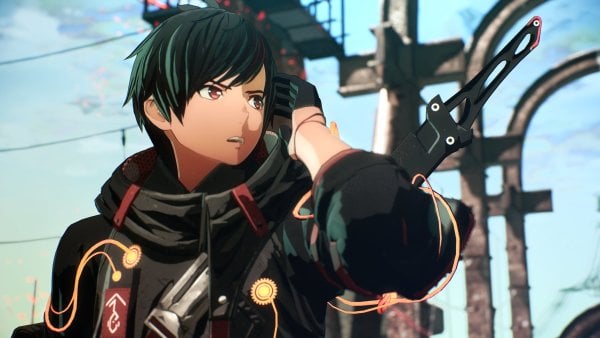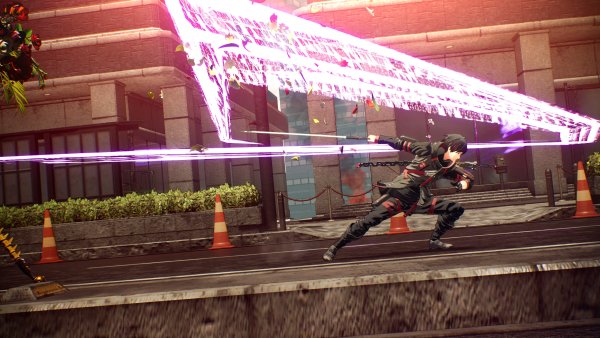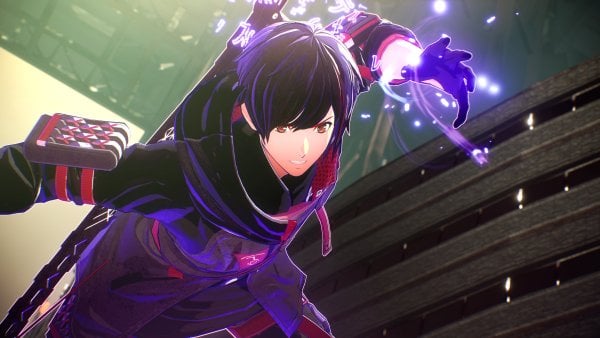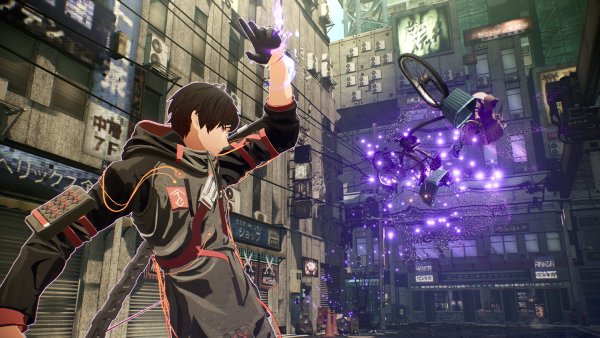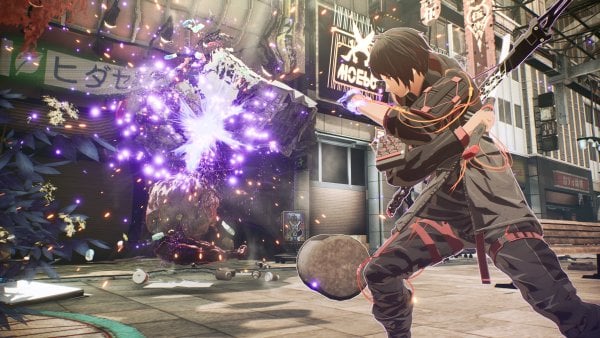Gamescom 2020, Developer discussion from gematsu:
Keita Iizuka, Producer: “Hello. I’m Scarlet Nexus‘ producer Iizuka.”
Kenji Anabuki, Director: “Hi. I’m Scarlet Nexus‘ director Anabuki.”
Kouta Ochiai, Art Director: “Hello, I’m Scarlet Nexus‘ art director Ochiai.”
■ Scarlet Nexus Team’s Creation
Iizuka: “At first… Bandai Namco Studios brought in the original proposal to us. And the project started when we, as Bandai Namco Entertainment, decided to work on the project as a new title. I think Mr. Anabuki had an idea of what he wanted to do and how to make it at the time.”
Anabuki: “I have been involved with the development of the Tales of series. There is a time when me and soem people in our company decided to do something new and challenging, so we organized as a new team quite suddenly, in order to deal with the project. And I think it was about five years ago.”
Iizuka: “Yes, about five years ago.”
Anabuki: “That time in our company, we started making prototypes for research and development purposes. It was exactly four years before when the product took shape and when we showed it to Bandai Namco Entertainment.”
Iizuka: “Thinking back, we definitely had a small and limited number of members working in the team. When you first brought in the project proposal, I remember that there were only three or four members working on that.”
Anabuki: “Also, Mr. Ochiai joined the team when I asked him to become a member in charge of the art.”
Ochiai: “At first, there was only that idea of making a new RPG in the team. We didn’t even have a precise theme for it, but we did want to make something new and though, ‘What is innovative and fresh?’ That’s when our team started brainstorming ideas on elements which reflect that ‘freshness’ and it just took off and the game became what it is today.”
■ Can you tell us a bit more about your backgrounds?
Iizuka: “I am the producer of Code Vein, which is a console game released last year. Before that, I had been producing smartphone games.”
Anabuki: “Also mentioned previously, I oversaw the Tales of series and had been working on about five to six titles, and in those games I had worked on battle mechanics and maps. Also, I have worked as the game director for two other projects.”
Ochiai: “I think of myself as a special case because I don’t have any representative works and have been working on many different game titles. For example, I have worked on The Idolmaster franchise, character designs of Soulcalibur, and the game effects and user interfaces for miscellaneous game titles. Also, God Eater is one of the games I’ve largely participated in. However, to be honest, I actually participated in many different projects. When I first debuted as an art director, I was working on this 3DS puzzle game called Trioncube… You can search it up on the web and you might find my name there.”
■ Why “Scarlet Nexus“?
Iizuka: “Scarlet Nexus is made up of two concepts, where ‘Scarlet’ means ‘red’ and ‘Nexus’ means ‘connection.’ The visual expression of ‘objects or persons connected with red lines represents a big part in the visuals and key art of Scarlet Nexus. Moreover, there is also an important meaning in the title itself. When the player borrows power from his teammates, you will see red tubes stabbed into the character’s back. This is one of the main characteristics of the game.”
Anabuki: “Also, Mr. Iizuka mentioned the keyword ‘red lines’ previously, which you can also find in the theme song, ‘Dream in Drive’ by The Oral Cigarettes.”
Ochiai: “Another interpretation for the title ‘Scarlet Nexus‘ can also be ‘red bonds.’ When we started making the game, we wanted to show off the concept ‘kizuna’ (bonds) in different ways. That’s why we also used expressions such as ‘red strings,’ ‘lines that connect you with your buddies.'”
Anabuki: “Additionally, ‘red strings’ is also a frequently used keyword that is used in the game. You could memorize this as an important keyword while playing the game.”
■ A “Brain Punk Action RPG”
Iizuka: “Regarding the ‘Brainpunk’ aspect, in Scarlet Nexus‘ world, the brain is at the center of all expressions. Although the setting of Scarlet Nexus is based on a much more technologically developed society, the technology is actually centered on the brain’s development. Also, the characters have special powers by using the power of their brains. From this situation, we can see that it all comes down to the brain—the main theme of the game. That’s one of the reasons we set the game’s genre as ‘Brainpunk.'”
Anabuki: “Yes. Also, on the word ‘punk,’ it has interpretations such as ‘rebellion towards society’ or ‘minority.’ When Mr. Ochiai created the 1990s-Japanese-like artistic vision for the world, it actually sort of ended up cyberpunk-ish. However, we thought that, ‘We are definitely not just making another cyberpunk-inspired world.’ And just as Mr. Iizuka said previously about brains being the main theme of the game, that’s when we thought, ‘Isn’t Brainpunk a suitable word to describe our game?’ That is how we labeled Scarlet Nexus‘ game genre.”
Ochiai: “As Mr. Anabuki said previously, we often hear of the word cyberpunk or neopunk, and we are conscious that the ‘punk’ part means ‘rebellion.’ Moving forward, we thought that we can have something new deriving from it, such as ‘Steampunk’ or ‘Dieselpunk.’ In Scarlet Nexus, where the world is much developed on the brain, we decided to call it ‘Brainpunk.'”
Iizuka: “Yeah. We created this world vision that is starting from the close past, the 90s, but in an alternative reality where people discovered substances in the brain and developed their society greatly on that. Moreover, the story happening in a near future from our viewpoint and a world that is developed differently than ours is one of the main characteristics of the game.”
■ Scarlet Nexus‘ World
Ochiai: “I think we can talk about both the settings and the design on this topic. Firstly, on the settings part, the country portrayed in Scarlet Nexus is called New Himuka, which is an extremely huge country. We could even say that the country is so big that the concept of ‘overseas’ doesn’t even exist. In the country, there are very big cities with examples such as Suoh and Seiran. On the other hand, there is this opposing power, or location, called Togetsu. We won’t focus on other locations in Scarlet Nexus as we wanted to go deeper into the story surrounding the places mentioned before, which will be the main stage of the storytelling in the game. For the world perspective, as previously mentioned, we have put 90s-like elements into the game and one of the reasons for that is because we wanted to let players get into and immerse themselves in the game smoothly and easily, although being a completely new game title. We decided not to design a completely foreign or unknown vision
of a future society and its technological advancements, but to instead give the sense that the world is developed on the extended timeline based on our knowledge of the world.”
Anabuki: “Let me add to the explanation on New Himuka. As previously mentioned, the ‘brain’ is Scarlet Nexus‘ main theme and the technological advancement of the world is mostly surrounding it. Just like we are using electricity in our daily lives, these people are using their developed brain power. The people in this world don’t use devices like us, but just use their own brains to interact with the world around them. Also, their brains are connected to this big network called ‘Psynet’ and connect to services like infrastructure or medical services, etc. and interact with information. To conclude, New Himuka is a country where people are living under the ultimate vision of an IoT (Internet of Things) society under ‘Psynet.’ The fact that every brain is connected leads to a troubling issue that will be a big part of the storytelling, which we hope players will look forward to.”
Ochiai: “I think we have mentioned the ‘near future’ several times, and the year ‘2020’ also comes up in the game frequently. To further elaborate on that, the game actually doesn’t have a precise setting for the time period. It shows a vision of the world where sometimes, something is developed in a strange way, different from ours. And we are using ‘Brainpunk’ to describe the technologies seen in the game.”
Iizuka: “Yeah. The visuals actually look modern, or somehow futuristic. However, the base of all technologies in Scarlet Nexus‘ world is different from ours. For example, we use our voices to control electronic devices, but in the game’s world, people use their minds to interact with objects. In addition to that, there are the mysterious and scary entities called Others. All this adds up to the foreignness that we wanted to portray in the game contrasting with having modern visuals that we are familiar with. We hope that players will enjoy discovering this strange and familiar world that we have created.”
■ Yuito Sumeragi
Anabuki: “The story starts from the point when Yuito looked upon to the OSF and joined the force. In the country New Himuka where everyone’s brain is connected to a huge network called the ‘Psynet,’ when he is fighting for the OSF, he comes to be suspicious, such as ‘Is the OSF I have been trusting really acting for justice?’ Especially when every moment your brain is connected with your team members, is it really a good thing? Of course, you can borrow their powers to fight, but just like our modern life when we are always connected on social media, is it really a good thing? There is this kind of an antithesis embedded into the game, so we’ll be glad if the players would experience this for themselves in the game.”
Ochiai: “We always say that a person is lonely when they are on their own. But even when we connect our brains, are we really not alone? In a society where everyone’s brains are forcibly connected, what is real loneliness? Although this is not the theme of the game, the player will be encountering these questions. While playing the game, we want the players to think deeply of what it means to be alone, and what it means to be connected.”
Anabuki: “The game’s theme is surrounding the bonds between the characters, and it is expressed by portraying how they are helping each other out. However, what happens after that is what we mainly want our players to experience, especially in the last parts of the story. We really want players to experience that while playing the game.”
Iizuka: “Well, Yuito himself entered the OSF because of his experience of being rescued and he wants to help others. However, the truth which is bured deep underneath is getting uncovered bit by bit in the course of the story. At the same time, with his bonds with the other characters, he starts to understand what he is supposed to do, and also what he should be doing while facing bigger threats like society itself. And the story will be told based on his bonds now, with his companions and based on his memory of the past. And also bonds whose connection might be slightly off. Ultimately, he will be facing a heavy decision and fighting on his own. This is how the story will be developing. Yuito Sumeragi is the protagonist of Scarlet Nexus. As mentioned previously, he is a member of the OSF fighting against the Others, protecting people from being attacked by them. Every year, there are new recruits getting into the OSF, and Yuito is one of them this year. He uses psychokinesis and a sword. He uses his sword as a weapon, and by combining the use of the sword and psychokinesis, he fights against the Others.”
Anabuki: “His family name is Sumeragi. He is also one of the descendants of the family who built the country. 2,000 years ago, Yakumo Sumeragi founded New Himuka, so Yuito is looked upon and considered to be born in a prestigious family. As Mr. Iizuka said, he is one of the new recruits and is in the 567th Class. He had been attack by an Other when he was a kid, and after he was rescued by a member of the OSF, although having expectations from the family to be a politician or a bureaucrat, he still wanted to get into the OSF. Scarlet Nexus‘ story starts when his enrollment test for the OSF happened.”
Ochiai: “I would like to talk about the design. One of the most difficult parts is that many Japanese RPG players would like to fight flamboyantly and look cool. Yet, in order to emphasize the foreignness element in the game, we needed to make the basic things look standard and simple. Still, we managed to achieve the current result by letting Yuito wield a sword and inserting red lines and cables to the design. Also, we made him wear a hood, which is one of his big characteristics. All the above gives players a cool experience while looking not too displaced compared to reality. Also, in the story, Yuito seems like he is unaware of his surroundings, but continuing along the plot where he discovers more about the world, he would feel strong emotions such as anger and sadness throughout the story. To express those emotions, we made him look kind and ordinary at first, in order to create contrast.”
■ The Others
Anabuki: “So in Scarlet Nexus, the Others are a threat to humans. They are these mysterious beings that rain from the skies and hunt for human brains. They do not have any consciousness and just attack humans with their instincts. You can compare them to earthquakes in Japan, which could be seen as natural disasters and could be daily occurrences. To be precise, they rain from a fog-like phenomenon, which is called the Extinction Belt that is high up in the sky, and with advanced technologies humankind came up with measures, although not 100 percent accurate, such as forecasts of when and where these creatures will be falling from above, so that people could take safety measures and get away from the areas. To deal with the Others, there is a system where the OSF, which the protagonist Yuito belongs to, will go to the specific areas and suppress them. That’s why instead of living in total fear in New Himuka, people rarely die under the system and sort of coexist with these horrifying creatures called Others.”
Iizuka: “These Others have been existing from a distant past and people already came up with measures to deal with and coexist with them. Although their existence is an unsolved mystery, people have been able to have normal daily lives, rather than living in complete fear amongst them.”
■ The Inspirations Behind Others’ Design
Ochiai: “As Mr. Iizuka mentioned, we are putting ‘foreignness’ as a keyword of the game, and Scarlet Nexus gives that uncanny and foreign feeling. The thought of something feeling off and alien is where we want our players to start having an interest in the game. When we were designing the monsters, we wanted to make something new and unusual, and also things that people will have interest in. That’s when I thought of finding an independent artist to design the monsters for us, because we wanted to get a different perspective on values towards the game in order to contribute to the foreignness factor. I tried searching for suitable candidates, and Masakazu Yamashiro appeared with artworks that matched closely with my imagination for the monsters’ design. He doesn’t have any work experience on game projects, but anyway we invited him to work on the project together. I would also like to further deep dive on the designs. As previously stated, we added some grotesque elements to everyday items such as flowers and household appliances. We have a rule on the designs, where we put organic things and inanimate objects together to create the Others. It also relates to the background of the Others which you can find out more in the game. By combining the two things that seem to repel one another visually, we are able to effectively express to the players that the Others are the kind of incomprehensible creatures that are conceptually and mentally different from us humans. As this rule also matches the style of Mr. Yamashiro’s artwork, we are able to take advantage of his skills in design and expressions.”
Anabuki: “I agree. I think that the characteristics of the Others are much emphasized, where organic and inorganic things visually repel each other when they are combined into a single being. In the first phases of the project, when we still didn’t even have the green light from our company, Mr. Ochiai found Mr. Yamashiro and said to me, ‘I think he is super great and I wanna use him.’ However, I told him we have no choice but to put that on hold as we didn’t have permission. When the project officially started, we immediately contacted him and when we saw the first artworks he created for the project, all of our team members were so surprised with the quality. Before that, to be honest, I was having doubts if having Mr. Yamashiro was a good idea, but all of my skepticisms were gone with the high-quality artworks he was able to provide us with, and we started our cooperation right away.”
Iizuka: “Yes, regarding the design of the Others, when I first saw them, they really looked like animals, but if you look closely you can see parts that are combined to construct them, such as plants, human and metallic parts. We cannot know if it’s living or not, but we definitely can feel that it doesn’t understand human speech or have the same consciousness as ours. Even in a much technologically advanced society, they are still creatures that we will be afraid of and fear. And to fight off entities like this, only people with supernatural powers will be able to deal with. The enemy designs were able to give off the feelings listed before, which I enjoyed right away and think that they are extremely suitable candidates for Scarlet Nexus.”
Ochiai: “Yes, it is also one of the charms of the game. Of course, they are these fearful creatures that attack humans without any emotion, they still have a tint of sadness and sorrow in them. This is also one of the expressive styles Mr. Yamashiro has, which also matched with our vision of the Others. ‘Aesthetic’ is one word we can use and there is also an explanation surrounding this. In Scarlet Nexus, as previously mentioned we used ‘foreignness’ in the game, and to achieve that we create a contrast by using the ‘usual’ and the ‘unusual.’ In the design of the Others, we attempted to use both ‘beauty’ and ‘death’ in the designs. That’s when the word ‘aesthetic’ came up, and when we searched it up in Japanese, ‘painting death beautifully’ and ‘expressing beauty with extreme means’ are what we came up with. There are many artists with artwork styles that match with the above conditions, and upon reviewing the many options we decided to work with an artist who would be able to embed subliminal messages into the enemies’ design. By battling against them in-game, we feel that players would be able to experience something new and rare, which is what we have been trying to achieve all along.”
■ Are there any areas of the game you wanted players to look for or pay attention to?
Anabuki: “We wanted the players to look for a psychokinetic action game experience. This time, we focused on the ‘superpower’ experience based around the protagonist’s psychokinetic power. Other than that, Yuito Sumeragi also uses a sword and weapons for melee attacks. The combination of sword action and psychokinesis is one of Scarlet Nexus‘ charming features, and that’s why we want players to take a close look at them.”
■ Scarlet Nexus‘ Frame Rate and Graphics
Anabuki: “On the Xbox One and PlayStation 4, it will be 30 frames per second and we are aiming for a full HD graphic resolution. On the next-gen hardware, Xbox Series X and PlayStation 5, the frame rate will be in 60 frames per second and we are aiming for 4K graphics. For the PC version, including Steam, you will be getting a 4K 60 frames per second experience if you have the recommended specifications for your device.”

